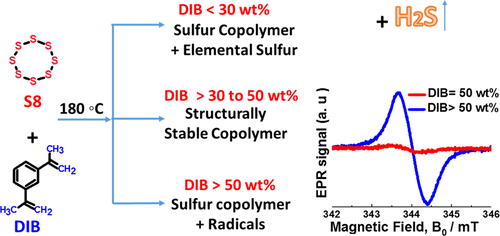Our official English website, www.x-mol.net, welcomes your feedback! (Note: you will need to create a separate account there.)
NMR and EPR Structural Analysis and Stability Study of Inverse Vulcanized Sulfur Copolymers
ACS Omega ( IF 4.1 ) Pub Date : 2018-03-20 00:00:00 , DOI: 10.1021/acsomega.8b00031 Vijay Kumar Shankarayya Wadi 1 , Kishore K Jena 1 , Shahrukh Z Khawaja 1 , Konstantina Yannakopoulou 2 , Michael Fardis 2 , George Mitrikas 2 , Marina Karagianni 2 , Georgios Papavassiliou 2 , Saeed M Alhassan 1
ACS Omega ( IF 4.1 ) Pub Date : 2018-03-20 00:00:00 , DOI: 10.1021/acsomega.8b00031 Vijay Kumar Shankarayya Wadi 1 , Kishore K Jena 1 , Shahrukh Z Khawaja 1 , Konstantina Yannakopoulou 2 , Michael Fardis 2 , George Mitrikas 2 , Marina Karagianni 2 , Georgios Papavassiliou 2 , Saeed M Alhassan 1
Affiliation

|
Sulfur copolymers with high sulfur content find a broad range of applications from Li–S batteries to catalytic processes, self-healing materials, and the synthesis of nanoparticles. Synthesis of sulfur-containing polymers via the inverse vulcanization technique gained a lot of attention due to the feasibility of the reaction to produce copolymers with high sulfur content (up to 90 wt %). However, the interplay between the cross-linker and the structure of the copolymers has not yet been fully explored. In the present work, the effect of the amount of 1,3-diisopropenyl benzene (DIB) cross-linker on the structural stability of the copolymer was thoroughly investigated. Combining X-ray diffraction and differential scanning calorimetry, we demonstrated the partial depolymerization of sulfur in the copolymer containing low amount of cross-linker (<30 wt % DIB). On the other hand, by applying NMR and electron paramagnetic resonance techniques, we have shown that increasing the cross-linker content above 50 wt % leads to the formation of radicals, which may severely degrade the structural stability of the copolymer. Thus, an optimum amount of cross-linker is essential to obtain a stable copolymer. Moreover, we were able to detect the release of H2S gas during the cross-linking reaction as predicted based on the abstraction of hydrogen by the sulfur radicals and therefore we emphasize the need to take appropriate precautions while implementing the inverse vulcanization reaction.
中文翻译:

反相硫化硫共聚物的NMR和EPR结构分析及稳定性研究
高硫含量的硫共聚物有着广泛的应用,从锂硫电池到催化过程、自修复材料和纳米粒子的合成。通过逆向硫化技术合成含硫聚合物由于可以反应生产高硫含量(高达 90 wt%)的共聚物而受到广泛关注。然而,交联剂和共聚物结构之间的相互作用尚未得到充分探索。在本工作中,深入研究了1,3-二异丙烯基苯(DIB)交联剂的量对共聚物结构稳定性的影响。结合X射线衍射和差示扫描量热法,我们证明了含有少量交联剂(<30 wt% DIB)的共聚物中硫的部分解聚。另一方面,通过应用NMR和电子顺磁共振技术,我们已经表明,将交联剂含量增加到50wt%以上会导致自由基的形成,这可能会严重降低共聚物的结构稳定性。因此,交联剂的最佳用量对于获得稳定的共聚物至关重要。此外,我们能够检测到交联反应过程中H 2 S气体的释放,正如基于硫自由基夺取氢所预测的那样,因此我们强调在实施逆硫化反应时需要采取适当的预防措施。
更新日期:2018-03-20
中文翻译:

反相硫化硫共聚物的NMR和EPR结构分析及稳定性研究
高硫含量的硫共聚物有着广泛的应用,从锂硫电池到催化过程、自修复材料和纳米粒子的合成。通过逆向硫化技术合成含硫聚合物由于可以反应生产高硫含量(高达 90 wt%)的共聚物而受到广泛关注。然而,交联剂和共聚物结构之间的相互作用尚未得到充分探索。在本工作中,深入研究了1,3-二异丙烯基苯(DIB)交联剂的量对共聚物结构稳定性的影响。结合X射线衍射和差示扫描量热法,我们证明了含有少量交联剂(<30 wt% DIB)的共聚物中硫的部分解聚。另一方面,通过应用NMR和电子顺磁共振技术,我们已经表明,将交联剂含量增加到50wt%以上会导致自由基的形成,这可能会严重降低共聚物的结构稳定性。因此,交联剂的最佳用量对于获得稳定的共聚物至关重要。此外,我们能够检测到交联反应过程中H 2 S气体的释放,正如基于硫自由基夺取氢所预测的那样,因此我们强调在实施逆硫化反应时需要采取适当的预防措施。



























 京公网安备 11010802027423号
京公网安备 11010802027423号